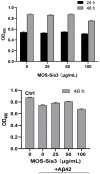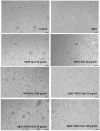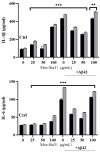An Oligomannuronic Acid-Sialic Acid Conjugate Capable of Inhibiting Aβ42 Aggregation and Alleviating the Inflammatory Response of BV-2 Microglia
- PMID: 34830217
- PMCID: PMC8621211
- DOI: 10.3390/ijms222212338
An Oligomannuronic Acid-Sialic Acid Conjugate Capable of Inhibiting Aβ42 Aggregation and Alleviating the Inflammatory Response of BV-2 Microglia
Abstract
Oligomannuronic acid (MOS) from seaweed has antioxidant and anti-inflammatory activities. In this study, MOS was activated at the terminal to obtain three different graft complexes modified with sialic acid moiety (MOS-Sia). The results show that MOS-Sia addition can reduce the β-structure formation of Aβ42, and the binding effect of MOS-Sia3 is more obvious. MOS-Sia conjugates also have a better complexing effect with Ca2+ while reducing the formation of Aβ42 oligomers in solutions. MOS-Sia3 (25-50 μg/mL) can effectively inhibit the activation state of BV-2 cells stimulated by Aβ42, whereas a higher dose of MOS-Sia3 (>50 μg/mL) can inhibit the proliferation of BV-2 cells to a certain extent. A lower dose of MOS-Sia3 can also inhibit the expression of IL-1β, IL-6, TNF-α, and other proinflammatory factors in BV-2 cells induced by Aβ42 activation. In the future, the MOS-Sia3 conjugate can be used to treat Alzheimer's disease.
Keywords: Alzheimer’s disease; microglia; oligomannuronic acid; sialic acid; β-amyloid.
Conflict of interest statement
There are no conflict to declare.
Figures










Similar articles
-
Alleviating neuronal inflammation induced by Aβ42 in SH-SY5Y through interaction with polysialic acid-oligomannuronate conjugate.Int J Biol Macromol. 2024 Sep;276(Pt 1):133862. doi: 10.1016/j.ijbiomac.2024.133862. Epub 2024 Jul 14. Int J Biol Macromol. 2024. PMID: 39013512
-
Resting microglia react to Aβ42 fibrils but do not detect oligomers or oligomer-induced neuronal damage.Neurobiol Aging. 2014 Nov;35(11):2444-2457. doi: 10.1016/j.neurobiolaging.2014.05.023. Epub 2014 May 29. Neurobiol Aging. 2014. PMID: 24973120
-
Neoechinulin A suppresses amyloid-β oligomer-induced microglia activation and thereby protects PC-12 cells from inflammation-mediated toxicity.Neurotoxicology. 2013 Mar;35:30-40. doi: 10.1016/j.neuro.2012.12.004. Epub 2012 Dec 21. Neurotoxicology. 2013. PMID: 23261590
-
Hybrids of oxoisoaporphine-tetrahydroisoquinoline: novel multi-target inhibitors of inflammation and amyloid-β aggregation in Alzheimer's disease.Mol Divers. 2019 Aug;23(3):709-722. doi: 10.1007/s11030-018-9905-5. Epub 2019 Jan 2. Mol Divers. 2019. PMID: 30603938
-
Sialic Acid Hydroxamate: A Potential Antioxidant and Inhibitor of Metal-Induced β-Amyloid Aggregates.Chembiochem. 2015 Jul 6;16(10):1448-53. doi: 10.1002/cbic.201500162. Epub 2015 Jun 8. Chembiochem. 2015. PMID: 25944626
Cited by
-
Sialic Acid-based Glycoconjugation on Myricetin-encapsulated Cationic Nanocarriers for the Treatment of Alzheimer's.Pharm Res. 2025 Jun;42(6):947-959. doi: 10.1007/s11095-025-03877-5. Epub 2025 Jun 9. Pharm Res. 2025. PMID: 40490615
-
Ameliorative Effect of Mannuronate Oligosaccharides on Hyperuricemic Mice via Promoting Uric Acid Excretion and Modulating Gut Microbiota.Nutrients. 2023 Jan 13;15(2):417. doi: 10.3390/nu15020417. Nutrients. 2023. PMID: 36678288 Free PMC article.
References
-
- Sošić M., Vuletic V., Tomić Z., Bogdanovic N. Diagnostic and therapeutic approach to a patient with cognitive impairment. Med. Flum. 2018;54:140–154. doi: 10.21860/medflum2018_198234. - DOI
-
- Flynn R.A., Pedram K., Malaker S.A., Batista P.J., Smith B.A., Johnson A.G., George B.M., Majzoub K., Villalta P.W., Carette J.E., et al. Small RNAs are modified with N-glycans and displayed on the surface of living cells. Cell. 2021;184:3109–3124.e22. doi: 10.1016/j.cell.2021.04.023. - DOI - PMC - PubMed
MeSH terms
Substances
Grants and funding
LinkOut - more resources
Full Text Sources
Miscellaneous

